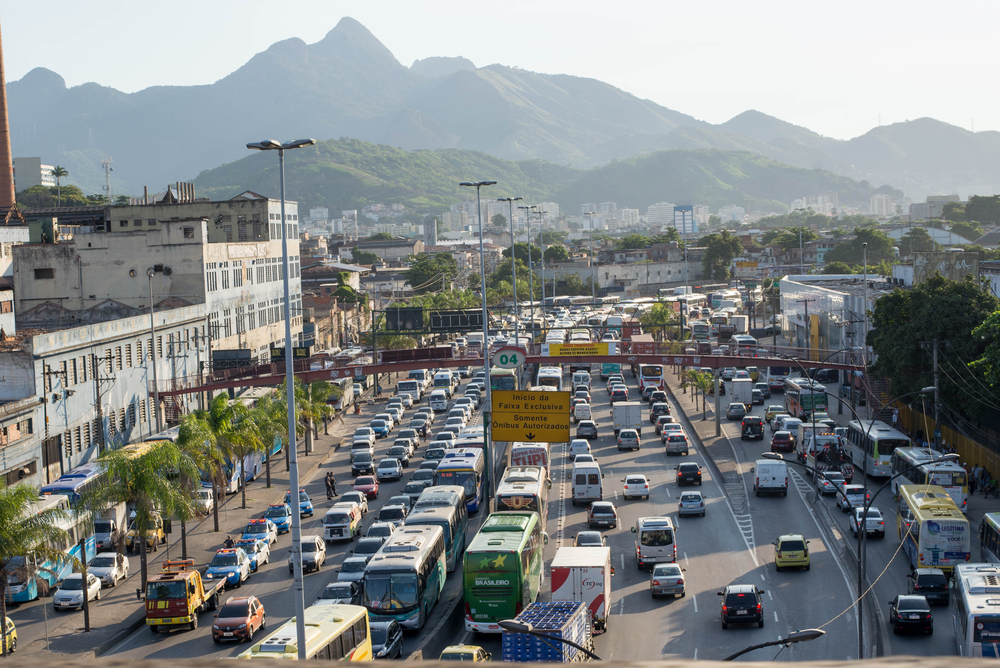In Latin American countries, where rapid urbanisation and population growth are common characteristics, the role of transportation in facilitating access to metropolitan areas and its consequent effect on regional economic performance is more important than it may initially appear. However, the traffic ‘gridlock’ is a significant challenge to many cities’ aspirations. Moreover, poor transport networks can lead to social segregation that has dramatic consequences for education, employment and economic growth (OECD, 2018). What is the solution?

Gridlock: a barrier to economic prosperity?
Characterised by severe congestion and prolonged travel times, gridlock has become a ubiquitous phenomenon in Latin American cities. The inefficiencies in transportation infrastructure, high concentration of workplaces in central urban areas, inadequate urban planning and burgeoning vehicle ownership exacerbate congestion levels (ECLAC, 2003). Consequently, the adverse effects reverberate across various facets of societal and economic life, hindering progress and stifling development, as every instance of traffic congestion consumes more fuel, time, and money for workers, businesses, and families alike. In OECD countries, cities contribute to 60% of total employment creation and GDP growth, where incomes are approximately 19% higher than elsewhere. In egalitarian countries, salaries tend to be 5-6% lower in less affluent neighborhoods; where urban mobility is more limited, unreliable, and there is inadequate access to transportation networks (OECD, 2016).
Gridlock has a detrimental effect on employment opportunities, as congestion leads to significant delays in commuting, resulting in lost productivity and increased absenteeism among workforces. Efficient and reliable transportation networks in urban centers where industries are concentrated can be a powerful tool for economic prosperity and social mobility (Jimenez, 2023).
Traffic also hinders educational attainment, particularly in poorer neighborhoods. Long commuted and limited public transport make it challenging for students to access schools and universities, which can detrimentally impact their academic progress (Harms et.al, 2003). Moreover, congestion-induced stress and fatigue can negatively impact students’ cognitive abilities and well-being, perpetuating cycles of educational inequality (Conte & Rüttenauer, 2022). This not only undermines human capital development but also impedes the emergence of a skilled workforce necessary for economic growth and innovation.
Finally, gridlock also stifles social and economic development at both local and regional levels, as it constrains the movement of goods and services, impeding market integration and hindering the growth of small and medium enterprises (Hartgen et.al, 2009). The opportunity cost of time lost in traffic congestion undermines peoples’ ability to engage in a range of activities, such as leisure, education, or entrepreneurial endeavors, thus constraining overall economic output and innovation. In Latin American the urban transport consumers more than 3.5% of the regional GDP (CEPAL, 2000).
The case of Bogota: Transmilenio and TransMiCable
At the end of last year, a celebrated article in the NY Times titled How One City Tried to Solve Gridlock for Us All was published, stating how Bogota’s transport system tried to solve the gridlock issue but has failed.
In the 1950s, the capital city of Colombia had a population of 600,000 people and envisioned itself as a regional reference with modern highways replacing regional railroads and trams. However, due to geopolitical and social issues, an unanticipated influx of people moved from rural areas towards the city, such that it’s current population stands at almost 8 million (DANE, 2024). The city made strides in addressing part of its transportation problem in the year 2000 when the rapid bus system (BRT), Transmilenio (TM), was installed. With 12 lines spanning over 114km and 1,500 buses, the system mobilised 1.5 million passengers per day (Center for Public Impact, 2016). Passengers saved 223 hours annually, equivalent to a 32% reduction in travel times. The bus system also decreased air pollutants in the city by 40%, leading to improved quality of life and subsequently increased property values of 15-20%. In this way, it contributed to job creation and improved the health and safety of the community (Turner et. Al, 2012). Bogota’s BRT system remains an exemplary case study whereby a city has leveraged the experiences of others (Curibitia and Quito) to create what is now the largest urban electric BRT system in Latin America (Center for Public Impact, 2016).
Currently, TM operates with seven modalities of vehicles, all functioning under the Integrated Public Transport System (SITP) umbrella, with a unified payment method. The system includes core infrastructure such as exclusive lanes that travel long distances, as well as a peripheral network that connects urban areas with to zones with low demand or limited access (Garcia, 2021). The creation of the TransMiCable, an aerial cable in Ciudad Bolivar, one of the poorest and densely populated districts of Bogota, transformed the lives of its residents and reduced travel time from 1.5 hours to 15 minutes (IFC, 2020). Additionally, in recent years, there has been a concerted effort to promote bicycling as a form of inter-modality transportation, with nearly 630 kilometers of bike lanes all linked to TM (Sánchez, 2023).
TM serves as living proof that low investment in infrastructure can still lead to improved livelihoods for commuters, leading to economic growth and social change. Above all, substantial change requires ongoing effort and patience.
Addressing the challenge
The lack of understanding of how congestion negatively impacts cities – and more importantly, people – is mainly why TM and other systems have not been successful. While it is true that Bogota needs a metro, the absence of a long-term vision beyond politics has also deeply affected the system. Addressing traffic gridlock requires a multifaceted approach that combines infrastructure investment, urban planning reforms, as well as sustainable and continued transportation policies. Investing in public transportation systems, including the expansion of metro networks, cycling lanes, and bus rapid transit systems, can provide viable alternatives and enhance connectivity, reducing inequality gaps based on spatial segregation.
In conclusion, traffic gridlock poses a formidable challenge to social and economic development in Latin American countries, undermining regional performance and perpetuating inequality. By recognising the interconnectedness of transportation, employment, education, and overall development, policymakers can devise holistic strategies to address congestion and unlock the full potential of urban centers. Through concerted efforts to improve transportation infrastructure, promote sustainable mobility solutions, and foster inclusive urban planning, Latin American countries can overcome the barriers posed by traffic gridlock and pave the way for a more prosperous and equitable future.
References
- OECD. (2018). Divided cities: understanding intra-urban inequalities. Available at: https://www.oecd.org/cfe/Divided-Cities_Policy-Highlights.pdf (accessed March 1, 2024)
- Economic Commission for Latin America and the Caribbean – ECLAC. (2003). Traffic congestion: The problem and how to deal with it. Available at: https://repositorio.cepal.org/server/api/core/bitstreams/d0851342-86b1-4aee-a262-0bedb95193cc/content (accessed March 1, 2024)
- OECD (2016). Making cities work for all. Available at: https://read.oecd-ilibrary.org/urban-rural-and-regional-development/making-cities-work-for-all_9789264263260-en#page3 (accessed March 1, 2024)
- Jimenez, N. (2023). The next wave of innovation in inclusive urban mobility. Available at: https://www.linkedin.com/pulse/next-wave-innovation-inclusive-urban-mobility-8p97e/?trackingId=7i2T9fQFS2uE2bMEnwGpzA%3D%3D#_ftn1 (accessed March 1, 2024)
- Harms, M. & Garrett, S. (2003). Disrupting links between poverty, chronic stress, and educational inequality. Available at: https://www.ncbi.nlm.nih.gov/pmc/articles/PMC10662171/ (accessed March 1, 2024)
- Conte, R. & Rüttenauer, T. (2022). London congestion charge: the impact on air pollution and school attendance by socioeconomic status. Available at: https://discovery.ucl.ac.uk/id/eprint/10155605/1/ConteKeivabu-Ruettenauer2022_London%20congestion%20charge_the%20impact%20on%20air%20pollution%20and%20school%20attendance%20by%20socioeconomic%20status.pdf (accessed March 1, 2024)
- Hartgen, D. & Gregory, F. (2009). Gridlock and Growth: The Effect of Traffic Congestion on Regional Economic Performance. Available at: https://reason.org/wp-content/uploads/files/ps371_growth_gridlock_cities_full_study.pdf (accessed March 1, 2024)
- CEPAL. (2000). Traffic congestion: its economic and social consequences. Available at: https://www.cepal.org/sites/default/files/publication/files/36298/FAL_Bulletin170_en.pdf (accessed March 1, 2024)
- Kimmelman, M. (2023). How One City Tried to Solve Gridlock for Us All. Available at: https://www.nytimes.com/interactive/2023/12/07/headway/bogota-bus-system-transmilenio.html (accessed March 1, 2024)
- DANE. (2024). Proyecciones de población desagregadas por localidades. Available at: https://www.dane.gov.co/index.php/estadisticas-por-tema/demografia-y-poblacion/proyecciones-de-poblacion/proyecciones-de-poblacion-bogota (accessed March 1, 2024)
- Center for Public Impact. (2016). TransMilenioÑ renewing Bogota’s transport system. Available at: https://www.centreforpublicimpact.org/case-study/transmilenio#:~:text=It%20was%20%E2%80%9Cdescribed%20as%20low,of%20air%20and%20noise%20pollution%E2%80%9D (accessed March 1, 2024)
- Turner et al. (2012). Colombia’s Bus Rapid Transit (BRT) development and expansion. Available at: https://www.worldtransitresearch.info/research/4411/ (accessed March 1, 2024)
- Garcia. D. (2021). To move in Bogotá: beyond numbers (and buses) A bicycle race. Available at: https://issuu.com/daniela-garcia-urbanism/docs/daniela_garcia_rojas_cr_to_move_in_bogot_beyond_n (accessed March 1, 2024)
- IFC – Riveras. I. (2020). A Cable Car Named Development. Available at: https://www.ifc.org/en/stories/2020/bogota-cable-car (accessed March 1, 2024)
- Sánchez, G. (2023). Entérate cuántos kilómetrod de ciclorrutas hay en Bogotá. Available at: https://bogota.gov.co/mi-ciudad/movilidad/movilidad-cuantos-kilometros-de-ciclorrutas-hay-en-bogota-este-2023 (accessed March 1, 2024)
Student voice
The Wheeler Institute for Business and Development is seeking to understand, illuminate and offer solutions to the challenges faced by the developing world, with an aim to identify the role of business in addressing these challenges and a focus on the implications and actions for those in developing countries. In support of our students, we approach this blog section as a reflective platform and a space where individuals can generate debate as long-term agents of positive change. This article is solely authored by a student and reflects their individual research, opinion and point of view and is not based on research led or supported by the Wheeler Institute.
About the author

Cristina Gamboa Peralta, MBA2025 is an Outreach and Communications Intern at the Wheeler Institute for Business and Development. Cristina holds both a Bachelor of Business Administration and a Bachelor of Laws from Universidad de los Andes, Bogota, Colombia. Before LBS, she worked as a Senior Associate at Boston Consulting Group (BCG), where she co-led a range of social impact projects with Compartamos con Colombia and various social enterprises, and initiated BCG’s first podcast for net-zero, social impact, and sustainability. Cristina has a keen interest in social impact and business solutions as a force for good, particularly in developing countries.
